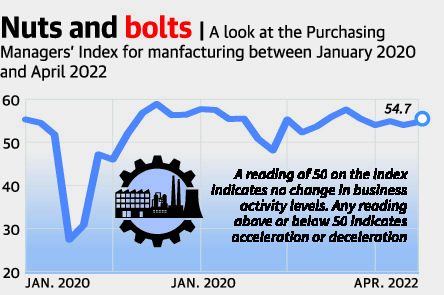Purchasing Managers Index | 06 May 2022
For Prelims: PMI, IIP, GDP, Inflation
For Mains: Growth & Development, PMI and its Significance, State of Economy.
Why in News?
According to the S&P Global India Manufacturing Purchasing Managers’ Index (PMI), India’s manufacturing sector recorded a slight acceleration in new orders and output which rose to 54.7 in April 2022 from 54 in March 2022.

What are the Key Highlights of the Index?
- April data showed a rebound in new export orders, following the first contraction for nine months in March.
- Contraction, in economics, refers to a phase of the business cycle in which the economy is in decline.
- A contraction generally occurs after the business cycle peaks, but before it becomes a trough.
- Inflationary pressures meanwhile intensified, owing to rising commodity prices, the Russia-Ukraine war and greater transportation costs.
- Input prices increased at the fastest pace in five months, while output charge inflation hit a 12-month high.
- A major insight from the latest results was an intensification of inflationary pressures, as energy price volatility, global shortages of inputs and the war in Ukraine pushed up purchasing costs.
- On the job front, there was only a mild increase in employment during April 2022.
What is the PMI?
- It is a survey-based measure that asks the respondents about changes in their perception of key business variables as compared with the previous month. It is an index of the prevailing direction of economic trends in the manufacturing and service sectors.
- The purpose of the PMI is to provide information about current and future business conditions to company decision makers, analysts, and investors.
- It is calculated separately for the manufacturing and services sectors and then a composite index is also constructed.
- The PMI is a number from 0 to 100.
- A print above 50 means expansion, while a score below that denotes contraction.
- A reading at 50 indicates no change.
- If the PMI of the previous month is higher than the PMI of the current month, it represents that the economy is contracting.
- It is usually released at the start of every month. It is, therefore, considered a good leading indicator of economic activity.
- PMI is compiled by IHS Markit for more than 40 economies worldwide.
- IHS Markit is a global leader in information, analytics and solutions for the major industries and markets that drive economies worldwide.
- IHS Markit is part of S&P Global.
- As the official data on industrial output, manufacturing and Gross Domestic Product (GDP) growth comes much later; PMI helps to make informed decisions at an earlier stage.
- It is different from the Index of Industrial Production (IIP), which also gauges the level of activity in the economy.
- IIP covers the broader industrial sector compared to PMI.
- However, PMI is more dynamic compared to a standard industrial production index.
What is the Significance of PMI?
- Provides a Reliable Expectation of Economy:
- The PMI is becoming one of the most tracked indicators of business activity across the world.
- It provides a reliable expectation of how an economy is doing as a whole and manufacturing in particular.
- Indicator of Economic Activity:
- It is a good gauge of boom-and-bust cycles in the economy and closely watched by investors, business, traders and financial professionals besides economists.
- PMI is also regarded as a leading indicator of economic activity since it is released at the beginning of every month.
- It comes before the official data on industrial output, core sector manufacturing and GDP growth.
- It is a good gauge of boom-and-bust cycles in the economy and closely watched by investors, business, traders and financial professionals besides economists.
- Helps in Decision Making:
- The PMI is used by central banks to set interest rates.
- Besides influencing equity market movements, PMI releases also impact bond and currency markets.
- Enhances Attractiveness of the Economy:
- A good reading of PMI enhances the attractiveness of an economy vis-a-vis other competing economies.
- Suppliers can decide on prices depending on PMI movements.
UPSC Civil Services Examination, Previous Year Questions
Q. What does S & P 500 relate to? (2008)
(a) Supercomputer
(b) A new technique in e-business
(c) A new technique in bridge building
(d) An index of stocks of large companies
Ans: (d)
- S&P 500 or Standard & Poor’s 500 is an American Stock index, which is widely regarded as the best gauge of large-capital US Equities.
